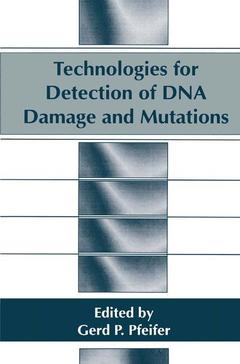Description
Technologies for Detection of DNA Damage and Mutations, Softcover reprint of the original 1st ed. 1996
Coordinator: Pfeifer G.P.
Language: English
Subjects for Technologies for Detection of DNA Damage and Mutations:
Keywords
DNA; Mammalia; PCR; Polymerasekettenreaktion; cell biology; genes; genetics; molecular biology; mutagenesis; polymer; reaction; transgen
Publication date: 06-2013
441 p. · 15.5x23.5 cm · Paperback
441 p. · 15.5x23.5 cm · Paperback
Description
/li>Contents
/li>Comment
/li>
Man-made carcinogens, natural genotoxic agents in the environment, as well as ionizing and ultraviolet radiation can damage DNA and are a constant threat to genome integrity. Throughout the evolution oflife, complex DNA repair systems have developed in all living organisms to cope with this damage. Unrepaired DNA lesions can promote genetic alterations (mutations) that may be linked to an altered phenotype, and, if growth-controlling genes are involved, these mutations can lead to cell transformation and the development of malignant tumors. Proto oncogenes and tumor suppressor genes may be critical targets for DNA damaging agents. In a number of animal model systems, correlations between exposure to a carcinogen, tumor develop ment, and genetic changes in tumor DNA have been established. To understand mutagenesis processes in more detail at the molecular level, we need to know the type and frequency of DNA adducts within cells, their distribution along genes and specific DNA sequences, as well as the rates at which they are repaired. We also need to know what types of mutations are produced and which gene positions are most prone to mutagenesis. This book provides a collection of techniques that are useful in mutagenesis research. The book is divided into three parts. In Part I, methods for DNA damage and repair analysis are provided.
Technologies for Detection of DNA Damage: Microgel Electrophoresis of DNA from Individual Cells: Principles and Methodology (N.P. Singh). The Cytokinesisblock Micronucleus Technique (M. Fenech). Agarose Gel Electrophoresis for DNA Damage Analysis (R. Drouin et al.). 32ppostlabelling for Detection of DNA Adducts (R.C. Gupta). A Postlabelling Assay for Oxidative Damage (M. Weinfeld et al.). Technologies for Detection of Mutations: Heteroduplex Analysis (D. Glavac, M. Dean). Mutation Analysis by Denaturing Gradient Gel Electrophoresis (DGGE) (R. Fodde, M. Losekoot). Single Strand Conformation Polymorphism Analysis (T. Sekiya). Twodimensional Gene Scanning (D. Li, J. Vijg). Ligase Chain Reaction for the Detection of Specific DNA Sequences and Point Mutations (R.B. Wallace et al.). Mammalian Systems for Mutation Analysis: Detection and Characterization of Mutations in Mammalian Cells with the pSP189 Shuttle Vector System (M.M. Seidman). The HPRT Gene as a Model System for Mutation Analysis (V.M. Maher, J.J. McCormick). Bacteriophage Lambda and Plasmid lacZ Transgenic Mice for Studying Mutions in vivo (J. Vijg, G.R. Douglas). The Use of lacI Transgenic Mice in Genetic Toxicology (J.G. de Boer et al.). Genotypic Mutation Assay (RFLP/PCR) (F. Aguilar, P. Cerutti). 16 additional articles. Index.
This important resource thoroughly reviews a wide range of techniques used in mutagenesis research, ranging from established techniques to recently developed methodologies, based on the polymerase chain reaction. DNA damage analysis, DNA repairs assays, and mutation detection are a few of the techniques featured. Chapters present detailed experimental protocols benefiting researchers and students in the fields of toxicology, biotechniques, molecular biology, photobiology, medical genetics.
© 2024 LAVOISIER S.A.S.
These books may interest you

Dna Replication In Plants 117.69 €

c-Myc Function in Neoplasia 116.04 €


